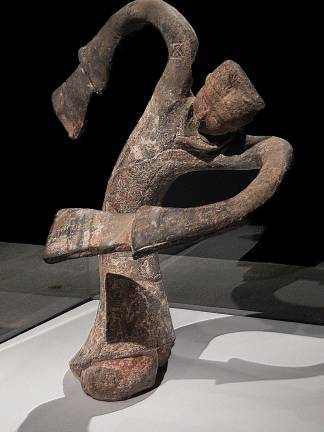ancient china unearthed








When a group of Chinese farmers hit an obstacle while digging a well in 1974, they unleashed an army. The Terracotta Army of Emperor Qin Shi Huang had stood watch over his funerary complex for more than 2,000 years. Modern replicas fill theme parks and have traveled the globe. But The Met Fifth Avenue has the real deal. And “Age of Empires: Chinese Art of the Qin and Han Dynasties (221 B.C.–A.D. 220)” is an imposing show of might.
A darkened gallery behind a wall of text greets the audience with a display of power. A life-sized kneeling archer is poised at one side of the room. Four standing warriors face from the opposite wall. Behind them, a shadowy photographic representation gives the sense of endless rows of additional soldiers, ready to fill in for vanquished comrades. In between, two charioteers reign a phalanx of four horses (replicas of the originals) into formation, ready to charge. All the pomp of a royal audience is expressed in the silent timelessness that fills the room.
It’s designed to give a sense of the Emperor Qin Shi Huang’s Mausoleum Museum, a UNESCO World Heritage Site near Xian, China. Whether it at all corresponds with being in the presence of the actual Terracotta Army is something only those who’ve visited it can say. But for those who haven’t, it’s an excellent introduction and a chance to see some of the most important archeological finds of the past century.
The warriors stand at the gateway to an extraordinary exhibition filled with rare works of historical import, most of which have never been seen before in the United States. More than 160 ancient Chinese works of art are included. There are examples of sculptures and painting, ceramics, textiles, bronzes and calligraphy. Arms and armor, spiritual and civic texts, decorative yet functional objects like lamps and vessels, and a spectacular one-of-a-kind mummy wrapped in jade fill the galleries. Together they give a sense of life at the highest court two millennia ago. All are on loan from museums and archaeological institutions in the People’s Republic of China, so don’t expect to have another chance to see them in one place at one time.
“The Han Empire represents the ‘classical’ era of Chinese civilization, coinciding in importance and in time with Greco-Roman civilization in the West. Like the Roman Empire, the Han state brought together people of diverse backgrounds under a centralized government that fostered a new ‘Chinese’ identity,” explained curator Jason Sun.
But, before there was a Han dynasty, there was the Qin. The Qin lasted only from 221–206 B.C., but laid the groundwork for a new civilization. The dynasty led by emperor Shi Huang is credited for introducing standardized weights and measures, examples of which are on view, as well as legal and monetary systems that extended across regions, and for building roads and canals, and beginning the Great Wall.
Beyond that, he sought immortality. Some 700,000 laborers were reportedly used to create both his army and a comfortable afterlife. His and other funerary sites were filled with musicians and dancers (whose charming forms grace the exhibition), feasting (stunningly naturalistic replicas of goats, cows, pigs and chickens are a highlight), and lots and lots of bodyguards. Shi Huang started his tomb as soon as he took power. According to some historians, Shi Huang, wanting to protect his burial site in eternal elegance, had his son bury alive all the artists and workers who’d fashioned it, so its location would remain a secret.
Building upon the Qin’s foundations, the Han dynasty, which lasted by contrast for more than 400 years, took to maintaining and continuing a lasting, powerful and productive society. The sections that follow the focus on the Qin dynasty present artifacts from the Han, as well as objects that testify to the growing importance of international commerce. Both the Silk Road, which evolved during the Han dynasty, and maritime trade brought Persian and Hellenistic influences, as well as exotic materials like amethyst, aquamarine, beryl and rock crystal.
Don’t expect a lot of imperial bling in this exhibition, though. These ancient works represent, largely, the stuff of life, even if transported to the afterlife.
As you go through the exhibition, marvel at the artworks, learn more about our world, but don’t envy the lifestyles of the rich and famous. The emperor Shi Huang, who built an army of warriors that lasted 2,200 years, ruled for little more than a decade, during which he survived three assassination attempts. His first son was forced to commit suicide by political enemies, and another son ruled for a scant three years.
But the advancements started under the Qin and developed under the Han led to a unified China. “Even today,” curator Sun said, “most Chinese refer to themselves as the ‘Han people’ — the single largest ethnic group in the world.”